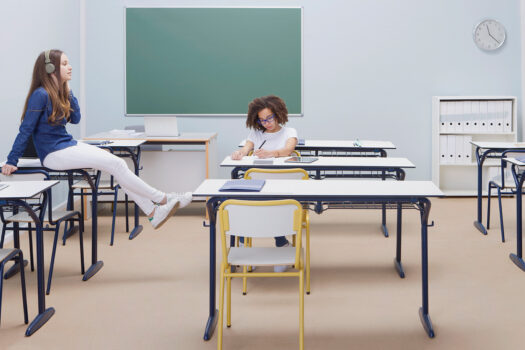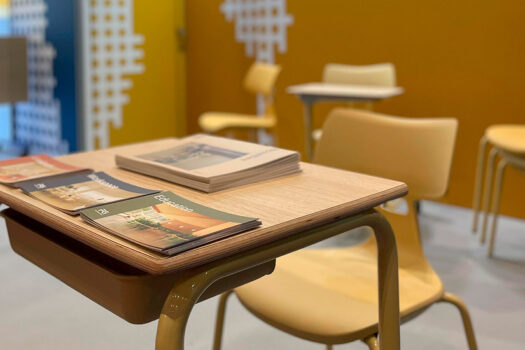Education is made by teachers and students. But the environment in which it takes place is also important to promote teaching. And one of the elements that determines that environment is architecture. That’s why we wanted to know Gabriel Verd’s thoughts on architecture and education. Gabriel Verd is an architect specialized in the design and construction of buildings of various kinds, particularly those used by the educational sector.
Verd sees each school as a tailor-made suit that must promote creativity and learning and must be able to adapt to the evolution of different methodologies.
Visiting professor of the Project subject at the Facoltà di Architettura di Cagliari (Italy) from 2009 to 2011, he has participated in numerous national and international competitions and has designed and built both public and private schools.
His projects have been published in national and international magazines (AV, 2G, Detail, Casabella, Domus, Area) and his list of awards includes the International Sustainable Architecture Award Fassa Bortolo 2009 (Ferrara, Italy), the Archi-Bau Award 2009 (Munich, Germany), and the International Architecture Award 2007 from the Chicago Athenaeum (USA).
1. How would you define the relationship between architecture and education?
Many of us spent our childhood and adolescence being educated in spaces designed simply to fit twenty-five desks. Even so, that is where we learned to read, write, and add, formed lifelong friendships, and trained to work and think.
We understand that the role of the architecture we design is to complement that of the educational institution it houses. Its image is part of each individual’s identity, represents a collective, and should serve as a complement to the teaching activity carried out there. This is my school. We design spaces that serve for more than just housing students, promoting encounters and coexistence, facilitating all kinds of teaching activities, motivating and encouraging creativity.
We also aim to create serene spaces because both soulless, monotonous spaces and those that overwhelm and excessively stimulate the student are equally problematic. Each level of education requires its own characteristics. In our projects, the main players are three: students, teachers, and families.
2. How important do you consider the architecture of an educational institution in teaching?
In our case, we see buildings as “artifacts” that help mediate between the teacher and the student. Everything adds up, of course, but the fundamental role must be that of the teacher. In fact, the first schools didn’t require buildings. They were held under the shade of a tree. In our memories, we always remember a teacher who marked us when we were students, others passed completely unnoticed, and there are some whose names we don’t even remember. Yet, they all taught under the same roof.
3. Do you think the architecture of the school contributes in any way to improving student motivation and attention?
Of course. A classroom in which the furniture and lighting have been studied, that has been correctly oriented, and that promotes communication between teacher and student will always work better than another space where these elements have not been considered. We live in an era where students are well-connected to the world through television, tablets, video games, and mobile phones… There are too many stimuli, and architecture must be able to facilitate motivation and focus students on teaching and the content being taught.
4. What are the latest trends in this field of architecture?
The methodology of Montessori schools, the multiple intelligences of schools like Montserrat… It is also being discussed how to educate through projects, as seen in the Santo Ángel schools, and the focus on teaching competencies. Additionally, each center has its own ideologies. These are pedagogical currents that inevitably affect the way we design. We treat each project as a tailor-made suit that can adapt to the evolution of different methodologies.
5. What values or principles do you integrate into your projects focused on the educational sector?
In our projects, there is always a concern for the integration of the building into its surroundings. We always consider sustainability from various perspectives, not just environmental, but also economic, social, and cultural. As a result, we create buildings specific to each place and each client. No two are the same.
6. What needs do educational centers currently face and how do you address them?
There is a need for spaces that are easy to maintain and flexible to accommodate the maximum number of uses. Perhaps the key is the indeterminacy of the spaces. On the other hand, very specific spaces with particular installations and furniture are also required. In this case, technology advances very rapidly, so construction solutions must be flexible to change.
7. How should architecture and school furniture work together to promote learning?
Architecture and furniture should be understood as a unit, as pieces of the same puzzle that fit perfectly. We think in terms of spaces to be furnished. School furniture should not be a mere decorative complement but is an essential element of the configuration of spaces that enable correct use. We cannot imagine one without the other.
8. What can you tell us about your relationship with FG in the design and creation of educational centers?
We are currently collaborating on several projects. We can achieve a lot together because our work philosophies fit perfectly.



